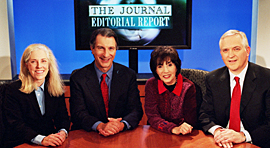

 |
Susan Lee (left) has left, but JER regulars Dan Henninger, Dorothy Rabinowitz and Paul Gigot are holding on for better carriage. (Photo: Don Perdue.) |
Since debuting on PBS nine months ago, Journal Editorial Report quickly became a program “everyone thinks they know about, even if they haven’t watched it,” says Stephen Segaller, production exec at presenting station WNET, New York.
Many critics of the Friday roundtable series helmed by Wall Street Journal Editorial Page Editor Paul Gigot assume CPB forced the series upon PBS to inject more right-leaning opinion into the schedule.
It was PBS President Pat Mitchell who courted Gigot to return to public TV, however. Mitchell, though she’s widely assumed to be a pal of Ted Turner and Jane Fonda, encouraged producers at Wall Street Journal Television to develop the show for PBS.
Though the New York Times reported May 2 that CPB Chairman Kenneth Tomlinson raised $5 million in corporate funding for Journal Editorial Report and pressed PBS to distribute it, Segaller and Journal execs say they’re not aware of his involvement in finding underwriting before the show’s launch in September 2004.
“I’ve never met Mr. Tomlinson and I’ve never spoken to him, and I handled all the arrangements for the show,” said Kathryn Christensen, v.p. of Wall Street Journal Television. The series, which recently sold a $1.5 million sponsorship to Shell Oil, is still struggling to gain carriage among major-market public TV stations, she said.
The show has been mischaracterized politically as well, Segaller says. The Journal’s editorial board isn’t a bunch of patsies for President Bush; the board members disagree with each other and frequently criticize the Bush administration and Republicans in Congress, he says.
“They’ve been very hard in recent weeks on the Republican leadership in Congress for forgetting its supposed economic principles. It’s not a discussion program that lacks diversity of points of view or people disagreeing with each other.”
The series came to PBS through the same initiative that brought Tucker Carlson: Unfiltered to the Friday primetime feed, although Journal Editorial Report took a more circuitous route to get on the air.
When PBS solicited proposals in 2003 to bring “more diverse voices to PBS,” Christensen collaborated with producers at the Nightly Business Report on a proposal that didn’t make the cut. PBS and CPB jointly backed a competing proposal to bring conservative pundit Carlson to pubTV.
“CPB said that it liked Carlson, but it also wanted Journal Editorial Report to add to the mix,” PBS programming exec Jacoba Atlas explained during a March meeting of the PBS Editorial Standards Review Committee.
CPB also backed development of a weekly series featuring conservative film critic Michael Medved, which now has a renewed chance to reach the air with NPR contributor and screenwriter John Ridley as co-host, according to John Davies, executive producer.
Mitchell contacted Gigot early last year about working up a new concept, says Christensen. In a meeting to discuss the possibilities, Mitchell “definitely spoke of how PBS was searching for more points of view to add to its lineup of public affairs shows,” Christensen says. Mitchell didn’t talk explicitly about the need to balance PBS’s public affairs lineup or mention other programs by name, she recalled.
To get Journal Editorial Report on the air during the fall presidential campaign, CPB gave the series $4.5 million. The grant covered startup costs and 35 episodes, running through May. The corporation recently committed $750,000 more to supplement Shell Oil’s corporate sponsorship of the program through this year.
PBS didn’t designate the series for common carriage, however, giving stations leeway to air the program over the weekend, or never, without hurting their common carriage performance. As a result, with programmers already complaining about a surfeit of public affairs on Friday evenings, many stations don’t air the show then.
“At this point, our bigger concern is these very large markets where we’re not aired at all,” Christensen says. Among Nielsen’s 30 largest TV markets, public TV stations in Dallas, Phoenix, Sacramento, San Diego and Raleigh-Durham don’t broadcast Journal Editorial Report, Christensen says. In Chicago, Boston, Atlanta and Charlotte, the series airs on secondary stations. Detroit’s WTVS and Nashville Public Television air it in the wee hours of Saturday morning, she says. KCET in Los Angeles, which has aired JER at 2 a.m., recently upgraded the series to a Saturday midday slot.
“We were pretty astonished that individual programmers could unilaterally decide not to let their viewers decide the worthiness of a program that CPB and PBS support, and that is produced by one of the most trusted newspapers in the country,” Christensen says.
“It has gotten decent carriage, but we’re still working to make it better,” says WNET’s Segaller. With Tucker Carlson: Unfiltered and Wall Street Week with Fortune dropping out of PBS’s Friday feed next month, he sees an opportunity to pick up new stations and secure better slots.
Web page
posted May 16, 2005
Copyright 2004 by Current Publishing Committee